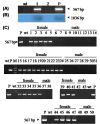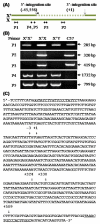Homologous illegitimate random integration of foreign DNA into the X chromosome of a transgenic mouse line
- PMID: 20707910
- PMCID: PMC2928235
- DOI: 10.1186/1471-2199-11-58
Homologous illegitimate random integration of foreign DNA into the X chromosome of a transgenic mouse line
Abstract
Background: It is not clear how foreign DNA molecules insert into the host genome. Recently, we have produced transgenic mice to investigate the role of the fad2 gene in the conversion of oleic acid to linoleic acid. Here we describe an integration mechanism of fad2 transgene by homologous illegitimate random integration.
Results: We confirmed that one fad2 line had a sole integration site on the X chromosome according to the inheritance patterns. Mapping of insertion sequences with thermal asymmetric interlaced and conventional PCR revealed that the foreign DNA was inserted into the XC1 region of the X chromosome by a homologous illegitimate replacement of an entire 45,556-bp endogenous genomic region, including the ovarian granulosa cell tumourigenesis-4 allele. For 5' and 3' junction sequences, there were very short (3-7 bp) common sequences in the AT-rich domains, which may mediate the recognition of the homologous arms between the transgene and the host genome. In addition, analysis of gene transcription indicated that the transgene was expressed in all tested fad2 tissues and that its transcription level in homozygous female tissues was about twice as high as in the heterozygous female (p < 0.05).
Conclusions: Taken together, the results indicated that the foreign fad2 behaved like an X-linked gene and that foreign DNA molecules were inserted into the eukaryotic genome through a homologous illegitimate random integration.
Figures









Similar articles
-
Mechanism of random integration of foreign DNA in transgenic mice.Transgenic Res. 2013 Oct;22(5):983-92. doi: 10.1007/s11248-013-9701-z. Epub 2013 Mar 13. Transgenic Res. 2013. PMID: 23483296
-
A model for the mechanism of precise integration of a microinjected transgene.Transgenic Res. 1996 May;5(3):171-7. doi: 10.1007/BF01969706. Transgenic Res. 1996. PMID: 8673144
-
Generation of fad2 transgenic mice that produce omega-6 fatty acids.Sci China C Life Sci. 2009 Nov;52(11):1048-54. doi: 10.1007/s11427-009-0143-z. Epub 2009 Nov 24. Sci China C Life Sci. 2009. PMID: 19937203
-
Illegitimate DNA integration in mammalian cells.Gene Ther. 2003 Oct;10(21):1791-9. doi: 10.1038/sj.gt.3302074. Gene Ther. 2003. PMID: 12960968 Review.
-
Mechanism of chromosomal integration of microinjected DNA.Mol Biol Med. 1989 Aug;6(4):283-98. Mol Biol Med. 1989. PMID: 2695741 Review.
Cited by
-
Expression of a Chimeric Antigen Receptor in Multiple Leukocyte Lineages in Transgenic Mice.PLoS One. 2015 Oct 27;10(10):e0140543. doi: 10.1371/journal.pone.0140543. eCollection 2015. PLoS One. 2015. PMID: 26505904 Free PMC article.
-
Concatenation of Transgenic DNA: Random or Orchestrated?Genes (Basel). 2021 Dec 10;12(12):1969. doi: 10.3390/genes12121969. Genes (Basel). 2021. PMID: 34946918 Free PMC article. Review.
-
Embryonic Lethality in Homozygous Human Her-2 Transgenic Mice Due to Disruption of the Pds5b Gene.PLoS One. 2015 Sep 3;10(9):e0136817. doi: 10.1371/journal.pone.0136817. eCollection 2015. PLoS One. 2015. PMID: 26334628 Free PMC article.
-
Mechanism of random integration of foreign DNA in transgenic mice.Transgenic Res. 2013 Oct;22(5):983-92. doi: 10.1007/s11248-013-9701-z. Epub 2013 Mar 13. Transgenic Res. 2013. PMID: 23483296
-
DNA barcoding reveals that injected transgenes are predominantly processed by homologous recombination in mouse zygote.Nucleic Acids Res. 2020 Jan 24;48(2):719-735. doi: 10.1093/nar/gkz1085. Nucleic Acids Res. 2020. PMID: 31740957 Free PMC article.
References
-
- Nagy A, Gertsenstein M, Vintersten K, Behringer R. Manipulating the Mouse Embryo: A Laboratory Manual. 3. New York: Cold Spring Harbor Laboratory Press; 2003.
-
- Houdebine L-M. Animal Transgenesis and Cloning. 1. John Wiley & Sons Ltd; 2003. full_text.
-
- Bishop JO, Smith P. Mechanism of chromosomal integration of microinjected DNA. Mol Biol Med. 1989;6:283–298. - PubMed
Publication types
MeSH terms
Substances
LinkOut - more resources
Full Text Sources

